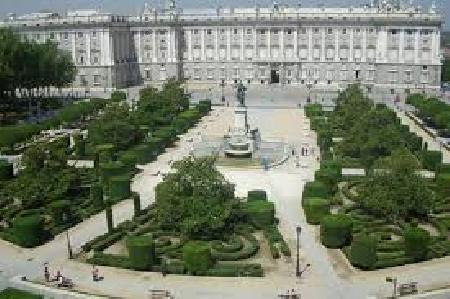
The Plaza de Oriente is a pedestrian plaza that borders the Royal Palace of Madrid. The square was designed in the mid-19th century and is adorned with small gardens and many statues.
Plaza de Oriente is behind Madrid's Royal Theatre , opposite the eastern entrance to the Royal Palace. From there, the dictator Franco once spoke to the Spanish people. Here in the Plaza de Madrid in late autumn - the anniversary of the dictator's death, and now crowds of neo-fascists are gathering. The square is shaped like a horseshoe. Its appearance is more similar to a square, where among the fountains and pruned trees there are limestone statues of the kings of the Spanish lands, who lived and ruled in the Iberian Peninsula from the 5th century. From the beginning, these statues were to serve as decoration of the architecture in the top of the Palace of the Kings. But due to their gravity and Elizabeth's nightmare, during which the busts fell due to the earthquake, the statues were never transferred to the palace.
The appearance of the Plaza de Oriente, unfortunately, is linked to an act of violence during which many Madrid residents were deprived of their roof. During a fire in 1734, the Royal Palace was burned. Its restoration lasted twenty-six years. Naturally, in so long, the area on the east side was built with houses of the inhabitants of Madrid. When Napoleon Bonaparte's older brother Jose became King of Spain, he did not like this neighborhood, as it was a direct threat to his life. By José's order, the territory was cleared: five hundred houses, a church and two monasteries were demolished.
The Plaza de Oriente was originally intended to be similar to the Champs Elysees in Paris, which had been moved to Madrid. Fortunately, the initial project was canceled, otherwise Madrid's architecture would have been damaged and the city's historical value, including the priceless treasure - the Monastery of the Barefoot Nuns.
The construction of the Plaza de Oriente in Madrid has lasted many decades. The entire architectural ensemble of the square was completed already during the reign of Queen Elizabeth II of Spain.
According to Queen Elizabeth's order, in the center of Plaza de Oriente, there was a statue of Felipe V sitting on a horse, who stood up. This Madrid architectural monument was created in 1640 by the sculptor Pietro Tacca. The sculptor was based on the portrait of the king made by the great Velázquez. The great Galileo Galilei helped to calculate the balance of a horse raised with a rider.
The square is famous for the Cathedral of Our Lady of Almudena. During the civil war, the architecture of the cathedral was bombed. It was restored and opened in 1993.
In the Plaza de Oriente there is another architectural monument of Madrid. It is the famous opera house, the Teatro Real, which was built by Antonio Aguado in 1850. Originally it was an open stage, which was expanded in 1737 for the talented singer Farinelli, who left a lasting impression on King Felipe.
The third site, which housed the Plaza de Oriente in Madrid, is also important. It is a playground near the residence of the kings, which is an example of the state's attitude towards young citizens.
Plaza Oriente offers many interesting sculptural compositions, including the monument to King Felipe II on horseback. This is the first equestrian statue in the world where a horse rests only on its hind legs. In the center of the square there is a monument to Felipe IV, around which there are 20 other statues of Spanish kings from different periods. In the mid-1990s, Baylen Street between the Royal Palace and Plaza Oriente was eliminated, which expanded the latter. In addition, pedestrian zones were created around the Teatro Real.
Many tourists are sitting on the terrace of the wonderful Café Oriente, admiring the magnificent gardens and historical monuments. This is where, inadvertently, they feel what the Spanish monarchy was.
